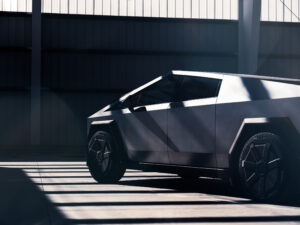
Tesla has released collision repair procedures, manuals, and service procedures on its new Cybertruck which includes uniquely repairable material.
The body structure components are made from varying grades of aluminum or steel that are either stamped, cast, or extruded.
Steel used on the Cybertruck are mild, high-strength, ultra-high strength, and stainless.
The stainless steel body has light and deep cosmetic scratch repairability, according to the OEM’s repair procedures. Tesla advertises its Cybertruck as having an ultra-hard stainless steel exoskeleton that helps reduce dents, damage, and long-term corrosion. The OEM also claims the vehicle’s glass is shatter-resistant, as tested with the impact of a baseball at 70 mph.
For example, to remove scratches from Cybertruck exterior body panels Tesla says:
-
- Refinish the entire plane (flat area) of the panel containing the repair area and the same plane across all panels on the same side of the vehicle to maintain consistency in appearance. Images with the procedures show that scratches in certain areas must be refinished, such as door panels, while others shouldn’t including the A- and C-pillars.
- Undamaged planes of the same panel don’t have to be refinished
Aluminum used on the Cybertruck body is cast, extruded, and 6xxx. Approved welders and welding wire are listed with the procedures.
It’s noted that a damaged part with an attached crash sensor can’t be repaired and the part must instead be replaced.
Tesla does not allow pulling or pushing of body structure components using frame straightening equipment or similar devices of any type. This includes any bonded, welded, weld-bonded, rivet-bonded, or riveted parts.
“Pulling or pushing the body structure can damage the integrity of the component or the joint (including mechanical fasteners or adhesive) between structural components, including those in seemingly unrelated parts of the body structure,” Tesla states in its structural repair guidelines.
Used, recycled, or aftermarket structural parts are also not allowed.
Cosmetic repairs to panels are allowed. As long as holes are not drilled in any panel for tooling access, paintless dent repair techniques are an acceptable method for repairing cosmetic panel damage, according to the repair guidelines.
Repairs on damaged body or structural components shouldn’t be performed near SRS components such as air bags, seat belts, impact sensors, and intrusion beams. The components should be replaced instead.
Images
Featured image: Tesla’s Cybertruck (Provided by Tesla)
Share This:
Related

